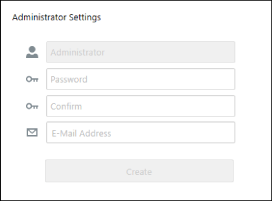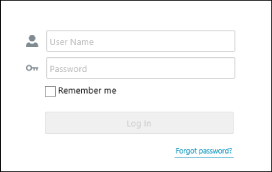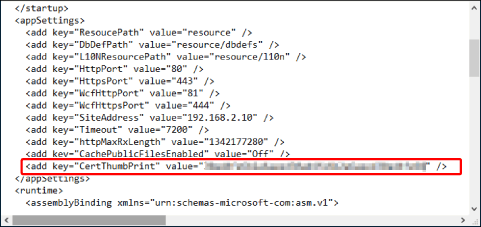Logging In to This Software
This section describes the method for accessing and logging in to this software, and the method for logging out.
If you forget your password, reset the password and then log in.
Logging In to This Software
1.
Enter the following URL in the web browser to access this software.
For the server computer where the Manager is installed: https://localhost:<port number>/
For a client computer: https://<FQDN or IP address of computer where Manager is installed>:<port number>/
For details on the operating procedure when a security warning is displayed in the web browser, see the following.
NOTE |
The port number can be omitted if the default port number (80 for HTTP, 443 for HTTPS) has not been changed. |
2.
When accessing this software for the first time after installation, set the system manager. If it is already set, enter the information for logging in.
When accessing this software for the first time
[Administrator Settings] is displayed.

In [Password] and [Confirm], enter the string to use as the Administrator password.
Enter the e-mail address of the administrator in [E-Mail Address].
Click [Create].
When the password is successfully set, the user is logged in as the Administrator and the [System] menu > [Preferences] page is displayed.
Proceed to configure the preferences. For details, see the following.
When the system manager is already set
The login screen is displayed.

Enter the user name and password, and click [Log In].
Select [Remember me] to retain the login state when the web browser is closed while the user is logged in. The retention period is five days.
Logging Out from This Software
1.
Select [Log Out] from the user information menu on the top of the screen.

Resetting the Password
1.
On the login screen, click [Forgot password?].
2.
On the [Reset Password] screen, enter the user name in [User Name], and click [OK].
An e-mail for resetting the password is sent to the e-mail address registered in this software.
3.
Access the URL indicated in the e-mail for resetting the password.
4.
On the [Reset Password] screen, enter the reset key included in the e-mail in [Reset Key], and enter the new password in [New Password] and [Confirm].
5.
Click [OK].
The password is reset.
Regarding the Certificate for Encrypted Communication
When this software is accessed immediately after installation, a web browser security warning is displayed. This is because unique information for the computer where this software is installed is not contained in the certificate included with this software. Communication is still encrypted in this case. In order to stop the warning from being displayed, it is necessary to create an authorized certificate and register it to the computer.
When Using the Certificate Included in This Software
If a warning is displayed in the web browser, follow the procedure below to access this software.
NOTE |
A warning may be displayed each time you access this software, depending on the web browser. |
Chrome
1. | Click [Advanced]. |
2. | Click [Proceed to <URL or name> (unsafe)]. |
Edge
1. | Click [Details]. |
2. | Click [Go on to the webpage (Not recommended)]. |
Firefox
1. | Click [Advanced]. |
2. | Click [Accept the Risk and Continue]. |
Internet Explorer
1. | Click [More information]. |
2. | Click [Go on to the webpage (not recommended)]. |
Using an Authorized Certificate
Follow the procedure below to use an authorized certificate.
1.
Create an authorized certificate for the computer where the Manager of this software is installed.
Create an appropriate certificate according to the type of certificate.
2.
Register the certificate to the certificate store.
Log on to the computer where the Manager is installed as a user with administrator privileges.
Right-click the Start menu, and select [Run].
Enter "certlm.msc" in [Open], and click [OK].
If the [User Account Control] screen is displayed, click [Yes].
On the left of the [certlm - [Certificate - Local Computer]] screen, right-click the folder to add the certificate to.
Select an appropriate folder according to the type of certificate created.
Select [All Tasks] > [Import].
Follow the instructions on the screen to register the certificate to the computer.
Double-click the registered certificate.
Click the [Details] tab on the [Certificate] screen.
Select [Thumbprint] in the [Field] list, and copy the string displayed on the bottom of the screen.
Paste the copied string to a text file and save the file.
Close the [Certificate] screen and the [certlm - [Certificate - Local Computer]] screen.
3.
Add the certificate information to the definition file of this software.
Log on to the computer where the Manager is installed as a user with administrator privileges.
Start Notepad with administrator privileges.
If the [User Account Control] screen is displayed, click [Yes].
Open the following file in Notepad.
%ProgramFiles%\Canon\EMC\Manager\ManagementConsoleService.exe.config
Add the following line as a child element of <appSettings>.
<add key="CertThumbPrint" value="<Thumbprint>" />
<Thumbprint> is the thumbprint string saved to the file in step 2.

NOTE |
The thumbprint string can be entered as is, even if it includes spaces. |
Save the file.
4.
Restart the service for this software.
Open [Windows Administrative Tools] > [Services] from the Start menu.
Restart the following service.
Canon Management Console Manager
5.
Access this software from a web browser and confirm that the warning is not displayed.